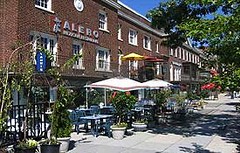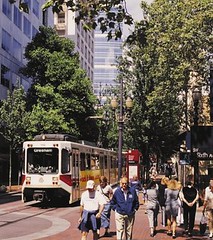We’re making a difference: sprawl is slowing as smart growth catches on

Posted March 18, 2008 at 7:52PM
One of the things that has challenged me as an advocate of smart growth is that, while we see substantial evidence of smarter development around us, we also continue to see a lot of sprawl. So it can really be hard to tell that we’re making any progress in our efforts to stop paving over every acre of our countryside and spending more and more time in traffic, emitting greenhouse gases and getting frustrated. Statistics have been hard to come by.
 But now we have some, and I’m here to report that they do, in fact, show that smart growth is starting to make a difference. In one of the most encouraging data sets I’ve seen, central cities are now starting to grow again, while the rate of growth in outer suburbs is declining. This is a huge change: when my colleagues and I were researching our 1999 book on sprawl, the trends could hardly have been more disheartening: we had statistics showing that the central areas of Atlanta, Kansas City, Los Angeles, Chicago, Cleveland, Washington, Baltimore and more were all losing jobs and population, while the counties around them were experiencing dramatic growth.
But now we have some, and I’m here to report that they do, in fact, show that smart growth is starting to make a difference. In one of the most encouraging data sets I’ve seen, central cities are now starting to grow again, while the rate of growth in outer suburbs is declining. This is a huge change: when my colleagues and I were researching our 1999 book on sprawl, the trends could hardly have been more disheartening: we had statistics showing that the central areas of Atlanta, Kansas City, Los Angeles, Chicago, Cleveland, Washington, Baltimore and more were all losing jobs and population, while the counties around them were experiencing dramatic growth.
This is no longer the case. Fringe counties are certainly still growing, but the near-total claim they once had on regional growth has disappeared. New analysis of census data from Dr. John Thomas at the US EPA shows that, since the mid-1990s, the portion of regional growth (as measured by housing starts) that is taking place in central cities and counties is on the increase, while the portion that is going to the sprawling fringe is starting to decline. While John’s analysis is not yet published, he has generously given us permission to share it. In particular:
- Cook County, IL went from roughly a 25% share of the Chicago Region’s new housing starts in the 1990s to over 40% in 2006
- Fulton County, GA increased it’s share in the Atlanta Region over the same period from 18% to 27%
- In the Washington, DC region, the District of Columbia, Arlington County and the City of Alexandria more than doubled their share of the regions housing starts (less than 10% throughout the 1990’s to over 23% in 2006.)
- Denver County doubled its share to 20%
- Multnomah County (Portland, OR) increased its share more gradually to roughly 25%
 We’ve been saying all along that rebuilding the urban core takes development pressure off the countryside. Now we can prove it. Given that we as a country are continuing to grow in population, jobs, and households, imagine the additional sprawl if those central cities had failed to recover.
We’ve been saying all along that rebuilding the urban core takes development pressure off the countryside. Now we can prove it. Given that we as a country are continuing to grow in population, jobs, and households, imagine the additional sprawl if those central cities had failed to recover.
But wait, there’s more good news: use of public transportation is rising again after decades of decline, while driving rates are beginning to slow.
In particular, according to the American Public Transportation Association, public transportation use is up 32% percent since 1995, a figure that is more than double the growth rate of the population (15 percent) and substantially higher than the growth rate for vehicle miles traveled (VMT) on our nation’s highways (24%) for that same period. Americans took 10.3 billion trips on public transportation in 2007, the highest level in 50 years. The share of walk-to-work commuting has also gone up since 1995.
 Meanwhile, although VMT continues to grow, the rate of growth in driving has significantly slowed, from 4-5% per year in the late 1980s and early 1990s to around 1% per year in the middle of the current decade. In 2005, the growth in vehicle miles traveled was less than 1% and less than the growth in population for the first time since the days of the OPEC oil embargo and block-long lines at the gas pump in the late 1970s.
Meanwhile, although VMT continues to grow, the rate of growth in driving has significantly slowed, from 4-5% per year in the late 1980s and early 1990s to around 1% per year in the middle of the current decade. In 2005, the growth in vehicle miles traveled was less than 1% and less than the growth in population for the first time since the days of the OPEC oil embargo and block-long lines at the gas pump in the late 1970s.
Now, I could pull out a different set of statistics demonstrating that we still have a long, long way to go. Rates of land consumption and driving in the US are still far higher than in most countries; availability and usage of public transportation are still much lower; commute times and distances continue to go up; suburban congestion is horrible; the gap between where we are in greenhouse gas emissions and where we need to be remains immense; and so on. Even with respect to the new, more hopeful trends, you can make a case that not every increment of improvement is a direct result of NRDC’s advocacy (but do keep it quiet). ;)
But this is progress, people. Remember that the smart growth movement didn’t even exist in its current form until the mid-1990s. We didn’t even have a name for it until Maryland’s then-governor Glendening popularized the phrase in 1997. But we found the right cause at the right time. And the things we have been advocating are starting to work. Maybe I’ll take the day off tomorrow.